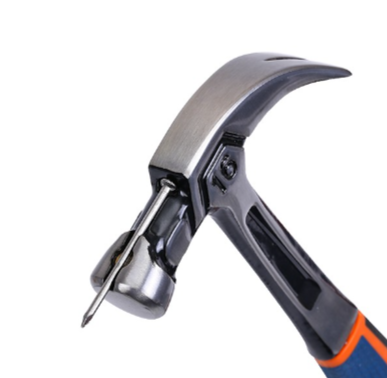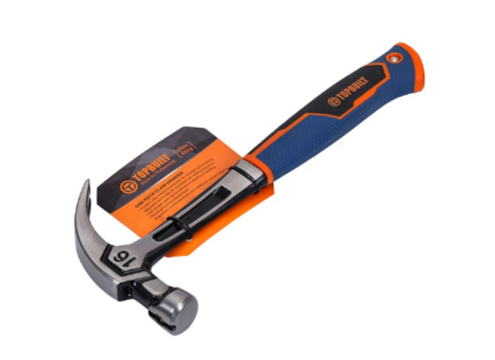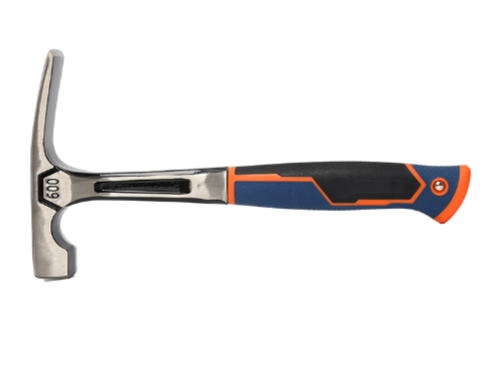The One Versatile Claw Hammer
 Jan 31, 2024|
Jan 31, 2024| View:165
View:165The claw hammer has a long-standing history as an essential tool in various industries and applications. From construction to woodworking, its versatility and functionality have made it indispensable.
Structurally designed to provide stability, control and power, a claw hammer usually consists of two main parts: the head and the handle.
The head of a claw hammer is usually made of metal, such as steel or iron. It usually has a curved shape, with the sides divided into two parts, claws and flat surfaces.
The claws are the upper part of the head and have a curved shape, similar to a sheep's horns. The claws generally have two sharp claws used for pulling out nails or other fixed objects.
The flat surface is the lower part of the head, usually a wider, flat surface. The flat surface is used for hammering nails or other objects.

The handle of a claw hammer is usually made of wood, fiberglass, or plastic. The handle connects the head and handle to provide the function of holding and controlling the tool.
The connection between the head and handle of a claw hammer is usually a strong fixation method, such as through bolts, pins or welding. This ensures a stable connection between the head and handle, allowing the tool to withstand the shock and pressure of use.
The handle design is usually cylindrical in shape to provide a comfortable grip. The end of the handle may have some texture or bumps to add stability and non-slip grip.
The material of the handle can be wood, fiberglass or plastic. Different materials have different characteristics, such as the traditional feel and comfort of wood, the lightness and durability of fiberglass, and the economy and anti-corrosion of plastic.
The claw hammer is a versatile hand tool that is used in a variety of different industries and tasks. The following is a description of the functions and common uses of a claw hammer:
Driving of Nails: A claw hammer is a primary tool used for driving nails. Its head design makes it easy to drive nails into wood, walls, or other materials. The flat portion provides a stable striking surface, allowing users to hammer nails with precision.
Nail removal: The claw part of the claw hammer is its unique feature. The shape and sharpness of the claws make it easier to remove nails. By inserting the claw into the head of the nail, the user can apply force and pull the nail out of the material.
Dismantling Work: The structure and strength of the claw hammer make it ideal for dismantling work. Whether you are dismantling wooden structures, dismantling furniture or dismantling building materials, the claws of a claw hammer can easily pry, dismantle and remove a variety of fixed objects.
Carpentry and Restoration Work: The claw hammer also plays an important role in carpentry and restoration work. It can be used to adjust, join, align and repair wood. The precise striking and extraction capabilities of a claw hammer make carpentry and restoration work more efficient and accurate.
General home use: In addition to the professional field, claw hammers also play an important role in home use. It can be used to assemble furniture, restore home decor, and perform small home repairs and DIY projects.

What are the advantages of a claw hammer over a traditional hammer?
Nail-removal ability: The claw hammer’s unique claw design makes it excellent at nail-removal. Traditional hammers typically do not have claws, so removing nails requires the use of other tools or methods. The claw hammer's claws can easily be inserted into the head of the nail, providing better leverage, making nail removal easier and more efficient.
Precise Control: Due to the shape of the claw hammer's head, the user has greater control and stability in the application of force. This makes it easier to apply precise force and perform meticulous operations during hammering or disassembly work, thereby increasing work accuracy and efficiency.
Adaptability: The curved part of the claw hammer can better adapt to different shapes and angles of work surfaces. Compared with the flat head of a traditional hammer, the claw hammer can better adapt to curved surfaces, corners or irregularly shaped work surfaces, making the application of force more efficient.
Versatility: Not only can the claw hammer be used as a regular hammer to drive nails, but it can also be used as a crowbar and demolition tool. The shape and sharpness of the claws enable it to easily pry, dismantle and remove a variety of fixed objects, making them suitable for disassembly work and repair tasks.
Provides extra leverage: Due to the curved design of the head, a claw hammer provides better leverage. This requires less force when removing nails or other objects, reducing labor intensity for the user.
Reduced risk of damage to the object: Due to the claw hammer’s claw design, nails are less at risk of being damaged during the removal process. In contrast, traditional hammers can cause damage to wood or other materials when removing nails, such as chipping or scratching when using pliers or other tools.

Can you give me some tips on using a claw hammer?
Choose the right claw hammer: Depending on the nature and requirements of the job, choose the right claw hammer. Consider factors such as the weight, length and material of the head and make sure it can handle the demands of the job.
Proper Holding: Hold the claw hammer firmly by the handle to ensure a secure hold. Keep your wrists and arms in a comfortable position to apply force and maintain control.
Accurate hitting position: Hit the head of the claw hammer accurately on the target object as needed. Ensuring the accuracy of the strike location improves work efficiency and accuracy.
Control force and angle: Control the force applied and the angle of the strike as needed. For hammering nails, apply just the right amount of force to ensure the nail is at the proper depth. For demolition work, adjust the angle and force to effectively remove fixed objects.
Nail grabbing technique: If you need to remove a nail or other fixed object, use the claw portion of the head of a claw hammer. Insert the claw next to the nail and apply upward force to disengage the nail.
Safety Note: When using a claw hammer, always wear appropriate personal protective equipment, such as safety glasses and gloves. Avoid working on unstable surfaces to prevent accidental injury. Store and store your claw hammer properly after use to avoid causing harm to others.
Practice and Proficiency: Mastering the technique of using a claw hammer takes time and practice. With experience and continued use, you will gradually improve your skills and become more proficient.





 English
English




